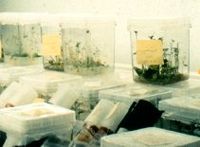
R2* and quantitative susceptibility mapping in deep gray matter of 498 healthy controls from 5 to 90 years
Sign Up to like & getrecommendations! Published in 2021 at "Human Brain Mapping"
DOI: 10.1002/hbm.25569
Abstract: Putative MRI markers of iron in deep gray matter have demonstrated age related changes during discrete periods of healthy childhood or adulthood, but few studies have included subjects across the lifespan. This study reports both… read more here.
Keywords: susceptibility mapping; quantitative susceptibility; gray matter; deep gray ... See more keywords

Quantitative susceptibility mapping of articular cartilage in patients with osteoarthritis at 3T
Sign Up to like & getrecommendations! Published in 2019 at "Journal of Magnetic Resonance Imaging"
DOI: 10.1002/jmri.26535
Abstract: Quantitative susceptibility mapping (QSM) has recently been applied in humans to quantify the magnetic susceptibility of collagen fibrils in the articular cartilage. read more here.
Keywords: mapping articular; susceptibility; articular cartilage; susceptibility mapping ... See more keywords

Voxel‐based quantitative susceptibility mapping in Parkinson's disease with mild cognitive impairment
Sign Up to like & getrecommendations! Published in 2019 at "Movement Disorders"
DOI: 10.1002/mds.27717
Abstract: Brain iron accumulation has been proposed as one of the pathomechanisms in Parkinson's disease (PD). This study aimed to examine the whole‐brain pattern of iron accumulation associated with cognitive impairment in patients with PD using… read more here.
Keywords: based quantitative; cognitive impairment; susceptibility mapping; voxel based ... See more keywords

Preconditioned total field inversion (TFI) method for quantitative susceptibility mapping
Sign Up to like & getrecommendations! Published in 2017 at "Magnetic Resonance in Medicine"
DOI: 10.1002/mrm.26331
Abstract: To investigate systematic errors in traditional quantitative susceptibility mapping (QSM) where background field removal and local field inversion (LFI) are performed sequentially, to develop a total field inversion (TFI) QSM method to reduce these errors,… read more here.
Keywords: field inversion; field; quantitative susceptibility; susceptibility mapping ... See more keywords

Suitable reference tissues for quantitative susceptibility mapping of the brain
Sign Up to like & getrecommendations! Published in 2017 at "Magnetic Resonance in Medicine"
DOI: 10.1002/mrm.26369
Abstract: Since quantitative susceptibility mapping (QSM) quantifies magnetic susceptibility relative to a reference value, a suitable reference tissue has to be available to compare different subjects and stages of disease. read more here.
Keywords: susceptibility; suitable reference; reference tissues; reference ... See more keywords

Cardiac quantitative susceptibility mapping (QSM) for heart chamber oxygenation
Sign Up to like & getrecommendations! Published in 2018 at "Magnetic Resonance in Medicine"
DOI: 10.1002/mrm.26808
Abstract: To demonstrate the feasibility of in vivo quantitative susceptibility mapping (QSM) in cardiac MRI and to show that mixed‐venous oxygen saturation (SvO2) can be measured non‐invasively using QSM. read more here.
Keywords: cardiac quantitative; mapping qsm; susceptibility mapping; qsm heart ... See more keywords

Phase processing for quantitative susceptibility mapping of regions with large susceptibility and lack of signal
Sign Up to like & getrecommendations! Published in 2018 at "Magnetic Resonance in Medicine"
DOI: 10.1002/mrm.26989
Abstract: Phase processing impacts the accuracy of quantitative susceptibility mapping (QSM). Techniques for phase unwrapping and background removal have been proposed and demonstrated mostly in brain. In this work, phase processing was evaluated in the context… read more here.
Keywords: phase processing; phase; susceptibility; large susceptibility ... See more keywords

Ultrashort echo time quantitative susceptibility mapping (UTE‐QSM) for detection of hemosiderin deposition in hemophilic arthropathy: A feasibility study
Sign Up to like & getrecommendations! Published in 2020 at "Magnetic Resonance in Medicine"
DOI: 10.1002/mrm.28388
Abstract: The purpose of this study was to investigate the feasibility of ultrashort echo time quantitative susceptibility mapping (UTE‐QSM) for assessment of hemosiderin deposition in the joints of hemophilic patients. read more here.
Keywords: ultrashort echo; time quantitative; mapping ute; susceptibility mapping ... See more keywords

QSMxT: Robust masking and artifact reduction for quantitative susceptibility mapping.
Sign Up to like & getrecommendations! Published in 2021 at "Magnetic resonance in medicine"
DOI: 10.1002/mrm.29048
Abstract: PURPOSE Quantitative susceptibility mapping (QSM) estimates the spatial distribution of tissue magnetic susceptibilities from the phase of a gradient-echo signal. QSM algorithms require a signal mask to delineate regions with reliable phase for subsequent susceptibility… read more here.
Keywords: reconstruction; phase; susceptibility; robust masking ... See more keywords

QQ-NET - using deep learning to solve quantitative susceptibility mapping and quantitative blood oxygen level dependent magnitude (QSM+qBOLD or QQ) based oxygen extraction fraction (OEF) mapping.
Sign Up to like & getrecommendations! Published in 2021 at "Magnetic resonance in medicine"
DOI: 10.1002/mrm.29057
Abstract: PURPOSE To improve accuracy and speed of quantitative susceptibility mapping plus quantitative blood oxygen level-dependent magnitude (QSM+qBOLD or QQ) -based oxygen extraction fraction (OEF) mapping using a deep neural network (QQ-NET). METHODS The 3D multi-echo… read more here.
Keywords: oxygen; quantitative blood; susceptibility mapping; oxygen level ... See more keywords

Blip up‐down acquisition for spin‐ and gradient‐echo imaging (BUDA‐SAGE) with self‐supervised denoising enables efficient T2, T2*, para‐ and dia‐magnetic susceptibility mapping
Sign Up to like & getrecommendations! Published in 2022 at "Magnetic Resonance in Medicine"
DOI: 10.1002/mrm.29219
Abstract: To rapidly obtain high resolution T2, T2*, and quantitative susceptibility mapping (QSM) source separation maps with whole‐brain coverage and high geometric fidelity. read more here.
Keywords: susceptibility mapping; acquisition spin; blip acquisition; gradient echo ... See more keywords